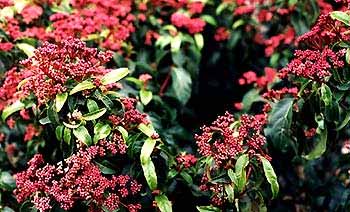 Laurustinus,
Laurustinus,
an Elizabethan Flowering Shrub
The common name of Viburnum tinus is Laurustinus. It is also called laurustine or laurustina, often spelled with one less "u", Laurestinus or Laurestine; or in French "Le Laurier tin." It is also known as the Guelder Rose. Laurus refers to the leaf having the appearance of bay laurel, & tinus means "tenth born" inferring "late arrival," an ancient name for an uncertain plant named in old literature, which may well have been Laurustinus named for blooming so late in the year.
A relative of honeysuckle, it is originally from the Mediterranean region of Europe & Africa, but has been cultivated in England a very long time & is well adapted to chillier temperate zones that approach zero degrees Fahrenheit in winter. When Shakespeare took a stroll in a pleasant London garden, this very viburnum is one of the plants he was apt to have seen.
Robert Browning likewise knew this plant:
This, that was a book in its time, Printed on paper & bound in leather Last month in the white of a matin-prime Just when the birds sang all together. Into the garden I brought it to read, And under the arbute & laurustine Read it, so help me grace in my need, From title-page to closing line.
Laurustinus can grow to eight feet high & wide, occasionally to twelve. There are many cultivars & ours is a scaled-down variety called 'Compactum' or 'Spring Bouquet' which will reach a maximum of six feet. It is identical to the longer established (since 1961) 'Eve Price' named for the wife of Sir Henry Price, & it has been questioned whether 'Compactum' is really a separate cultivar at all.
Compact Laurustinus has attractive bark & gnarly limb structure, but because of the density of the foliage, this feature is not obvious. It thrives in our Puget Sound weather & lends a garden considerable winter interest. First of all, it is a broadleaf evergreen with shiny leathery leaves attractive year round. In late October through February, the buds persist as large flattened clusters of small pink berry-like balls. These buds remain closed most of the winter but are so brightly pink they look like bright pink flowers. In the February portrait above left, of the Laurustinus we have beside our back door stoop, it looks as though it is in full bloom, though really it is only in full bud with, having held this appearance all winter long. These pink round buds will open in March & April into white mildly honey-scented flowers, & it will continue to be in bloom through May, though toward the end of their bloom the odor becomes terribly unpleasant for three or four days while it is most eager to attract pollinating flies. Beginning late May & especially in summer the most stunning little metallic blue berries develop & those will linger clear through to autumn, with a few still on the branches in winter though by then having turned black.
Tincture of V. tinus has lately entered into the herbal pharmacological choices as a cure for all manner of severe illnesses which it is not at all likely to cure, from deafness to depression to migraine & uterine cancer. That it may have some slighter medicinal value is worthy of investigation, though all that is certain is that stomach upset will result from eating the pretty but nasty tasting berries.
Laurustinus is sometimes deposited on the plant islands of parking lots. Alas, though it is adaptable to poor soils & even seems to prefer gritty unenriched soils, it nevertheless often looks dreadful when negleccted. In such an environment of disregard, it is subject to insect attack, getting black or white spots on the leaves, & without regular watering ends up looking very raggedy. It is somewhat less abusive to force several to be a hedgerow, but ideally it should be treated as a specimen plant & permitted to grow into a full bush to look its best. It does make a nice garden border or streetside plant if it receives moderate care.
Ours was originally planted at the foot of the backdoor steps due to its year-round charms, but when it went through its brief rank-smelling moments in early May, I moved it (before it was too-well established by the steps) to a streetside array of cared-for shrubs, near a Dawn Viburnum & the 'Anna Rose Whitney' Iron Clad rhododendron.
With normal care & watering, it is nothing at all like those grim parking lot specimens or over-trimmed hedges. It is very forgiving of being cut, however, & springs back swiftly, hence it is a good choice for long-lasting cuttings for bouquets.